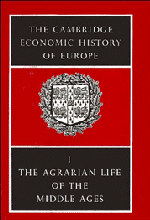Book contents
- Frontmatter
- Chapter I The Settlement and Colonization of Europe
- Chapter II Agriculture and Rural Life in the Later Roman Empire
- Chapter III The Evolution of Agricultural Technique
- Chapter IV Agrarian Institutions of the Germanic Kingdoms from the fifth to the ninth century
- Chapter V Agrarian conditions in the Byzantine Empire in the Middle Ages
- Chapter VI The Rise of Dependent Cultivation and Seignorial Institutions
- Chapter VII Medieval Agrarian Society in its Prime
- §1 France, The Low Countries, and Western Germany
- §2. Italy
- §3 Spain
- §4 The lands east of the Elbe and German colonization eastwards
- §5 Poland, Lithuania and Hungary
- §6 Russia
- §7 England
- §8 Scandinavia
- Chapter VIII Crisis: From the Middle Ages to Modern Times
- BIBLIOGRAPHIES
- Plate Section
- The Roman frontier and the Teutonic Tribes in the first and fourth centuries A.D.
- The Empire of Charles the Great
- Germany in the thirteenth century
- References
§1 - France, The Low Countries, and Western Germany
from Chapter VII - Medieval Agrarian Society in its Prime
Published online by Cambridge University Press: 28 March 2008
- Frontmatter
- Chapter I The Settlement and Colonization of Europe
- Chapter II Agriculture and Rural Life in the Later Roman Empire
- Chapter III The Evolution of Agricultural Technique
- Chapter IV Agrarian Institutions of the Germanic Kingdoms from the fifth to the ninth century
- Chapter V Agrarian conditions in the Byzantine Empire in the Middle Ages
- Chapter VI The Rise of Dependent Cultivation and Seignorial Institutions
- Chapter VII Medieval Agrarian Society in its Prime
- §1 France, The Low Countries, and Western Germany
- §2. Italy
- §3 Spain
- §4 The lands east of the Elbe and German colonization eastwards
- §5 Poland, Lithuania and Hungary
- §6 Russia
- §7 England
- §8 Scandinavia
- Chapter VIII Crisis: From the Middle Ages to Modern Times
- BIBLIOGRAPHIES
- Plate Section
- The Roman frontier and the Teutonic Tribes in the first and fourth centuries A.D.
- The Empire of Charles the Great
- Germany in the thirteenth century
- References
Summary
The general framework
The regime of the great estate in Western Europe underwent, between the eleventh and fourteenth centuries, a transformation which cannot properly be understood without some preliminary examination, in the same geographical and chronological framework, of three phenomena. These are the modifications which took place respectively in the extent of land under cultivation, in the management of the soil and in the character and distribution of landed property.
The extent of land under cultivation
One of the most essential features of the period under consideration is that it was a time of land reclamation on a large scale. This became extremely active from the second half of the eleventh century onwards, and was evidently associated with the growth of population which seems to have occurred at this time. The problem has been discussed in an earlier chapter but some recapitulation and expansion will be in place here.
In France, the movement appeared earlier in some regions than in others; land was being reclaimed from the sea in Flanders from the beginning of the eleventh and perhaps as early as the tenth century; the attack on the forests on the clay soils of the banks of the Saône and on the Beaujolais hills began in the second half of the tenth century; the first serious attacks on the forests of Normandy and Maine seem to date from the same time, while the attempts to bring the plain of Roussillon, ruined by the Arab invasions, under cultivation were perhaps earlier still. Nevertheless in the kingdom as a whole and in neighbouring regions like the Dauphiné, although the clearances sometimes began in the eleventh century, the twelfth and thirteenth centuries were the real age of reclamation. This is true alike of long-civilized districts like that between the Seine and the Loire and of the Alpine forest zone. Progress was not indeed uniform everywhere.
Keywords
- Type
- Chapter
- Information
- Publisher: Cambridge University PressPrint publication year: 1966
References
- 4
- Cited by

